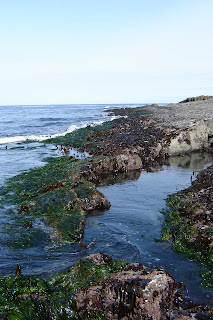Half of the group: The Boiler Bay Biodiversity Babes!
For all of the field trips we had this week, vertical zonation patterns in the intertidal were extremely important to consider when we were collecting data. There are three different zones we collected data from defined by the following:
Low-zone: The low zone is the area below mussel beds
Mid-zone: The mid-zone is the area where the mussel beds are found
High-zone: The high-zone is the area above the mussel beds that is characterized by species that can tolerate desiccation.

A view of the zonation (low and mid intertidal zones) at Boiler Bay.
This zonation is strongly structured by environmental gradients like tides, wave action, and temperature (related to desiccation and physiological processes). These characteristics change vertically as you move farther away from the ocean
Zonation also is a result of complex species interactions. For example, different distributions of barnacle species competing with mussels for space or seastars eating mussels. Overall, these environmental gradients and species interactions heavily influence the overall composition of the rocky intertidal and thus, likely had a large impact on the data we collected this week.
Lydia and Ashley working on a quadrat in the protected zone at Strawberry Hill.
We also started working on our mini research projects with the data the class has gathered over the last week. Some of the topics are predator diets, tide pool diversity, transect-quadrat data for community structure, and biodiversity throughout the intertidal. We also must mention the amazing potluck we had on Thursday night! Yay for delicious dinners and food babies!
